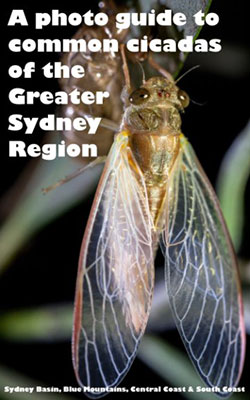A Photo Guide to Common Cicadas of the Greater Sydney Region
By Nathan Emery – (2016)
 31 pages; matt art paper, with 27 quality colour photographs, 1 frequency graph & 22 observation location maps.
31 pages; matt art paper, with 27 quality colour photographs, 1 frequency graph & 22 observation location maps.
Soft Cover: 20.3cm x 12.7cm
ISBN: 978-1-36-708611-1
Self-Published: Nathan Emery; nje.seed@gmail.com
Other than the marvelous and now out of print “Australian Cicadas” by Max Moulds (1990) I believe no other book has been published on Australian cicadas that is easily accessible to the general public, until now. Although this simple, small colourful book is not a complete works as was the Moulds book (at that time), it is still a very handy little book to own and is quite informative and simply written so any one can understand it and make use of its content.
It deals specifically with 22 common species of the greater Sydney region which includes 3 scientifically un-named taxa; 1 species of Myopsalta and 2 rather striking species of Yoyetta, which however have been given common names for this book. One may consider it odd to include 3 un-named taxa in this photo guide designed for the general public – but the facts are, Australia boasts the largest number of cicada species of all countries and less than half of those species have been scientifically named (only about 350 of the 750-900 Australian species have been named). We obliviously encounter un-named species with variable regularity during the spring and summer months and this book brings that to our attention not just through the text but also visually by giving us a look at some un-named species/taxa and that’s is exciting and generous stuff. Further, the author encourages the general public to become involved in part of a public science research and education program and such programs can be very beneficial to both parties. I am all for any educational programs that assist in bringing to light and or to inform the general public about the status of our environment and how it can be better looked after and enjoyed.
I like this book and I can certainly recommend it; the photos are generally clear and accompanied by the text and frequency graph would surely aid anyone reading this book in identifying local Sydney cicadas. My only real criticism is the lack of a bibliography; nothing annoys me more than natural history books or guides that lack some kind of bibliography and the author has published numerous “quality” original research/scientific papers on this subject and therefore I cannot understand the lack of this important element. However, I am sure the author will rectify this in coming editions which I sincerely look forward to reading and I encourage your readers to also take advantage of this book and its coming volumes.
Rod Rice
Principal Reviewer
Nature & Travel Books
